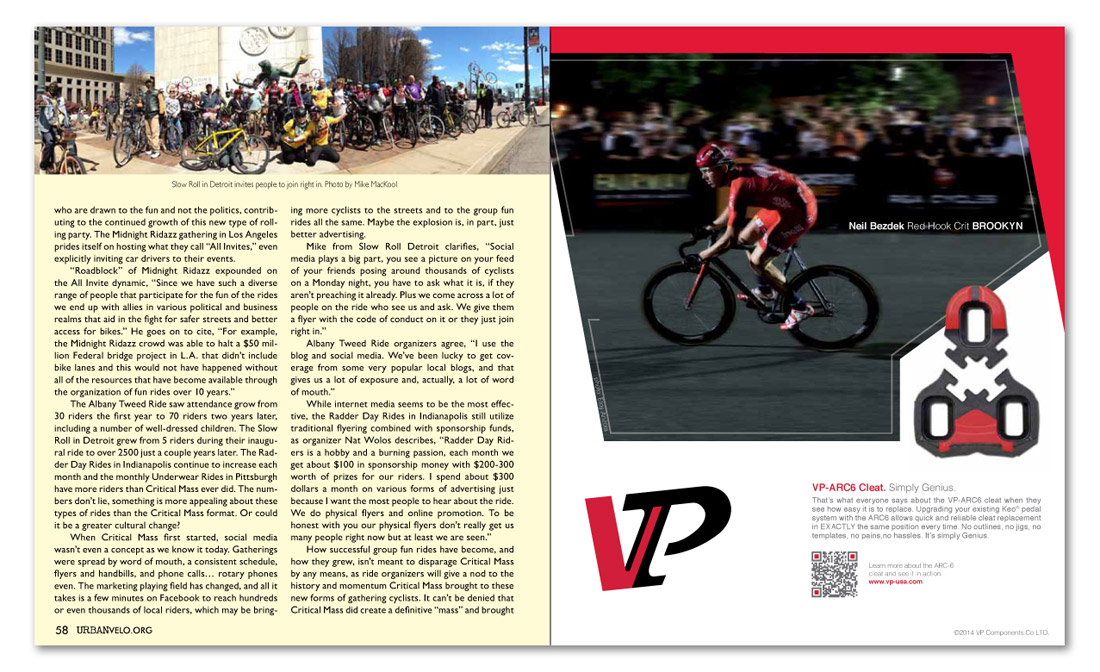


who are drawn to the fun and not the politics, contributing to the continued growth of this new type of rolling party. The Midnight Ridazz gathering in Los Angeles prides itself on hosting what they call “All Invites,” even explicitly inviting car drivers to their events.
“Roadblock” of Midnight Ridazz expounded on the All Invite dynamic, “Since we have such a diverse range of people that participate for the fun of the rides we end up with allies in various political and business realms that aid in the fight for safer streets and better access for bikes.” He goes on to cite, “For example, the Midnight Ridazz crowd was able to halt a $50 million Federal bridge project in L.A. that didn’t include bike lanes and this would not have happened without all of the resources that have become available through the organization of fun rides over 10 years.”
The Albany Tweed Ride saw attendance grow from 30 riders the first year to 70 riders two years later, including a number of well-dressed children. The Slow Roll in Detroit grew from 5 riders during their inaugural ride to over 2500 just a couple years later. The Radder Day Rides in Indianapolis continue to increase each month and the monthly Underwear Rides in Pittsburgh have more riders than Critical Mass ever did. The numbers don’t lie, something is more appealing about these types of rides than the Critical Mass format. Or could it be a greater cultural change?
When Critical Mass first started, social media wasn’t even a concept as we know it today. Gatherings were spread by word of mouth, a consistent schedule, flyers and handbills, and phone calls… rotary phones even. The marketing playing field has changed, and all it takes is a few minutes on Facebook to reach hundreds or even thousands of local riders, which may be bringing more cyclists to the streets and to the group fun rides all the same. Maybe the explosion is, in part, just better advertising.
Mike from Slow Roll Detroit clarifies, “Social media plays a big part, you see a picture on your feed of your friends posing around thousands of cyclists on a Monday night, you have to ask what it is, if they aren’t preaching it already. Plus we come across a lot of people on the ride who see us and ask. We give them a flyer with the code of conduct on it or they just join right in.”
Albany Tweed Ride organizers agree, “I use the blog and social media. We’ve been lucky to get coverage from some very popular local blogs, and that gives us a lot of exposure and, actually, a lot of word of mouth.”
While internet media seems to be the most effective, the Radder Day Rides in Indianapolis still utilize traditional flyering combined with sponsorship funds, as organizer Nat Wolos describes, “Radder Day Riders is a hobby and a burning passion, each month we get about $100 in sponsorship money with $200-300 worth of prizes for our riders. I spend about $300 dollars a month on various forms of advertising just because I want the most people to hear about the ride. We do physical flyers and online promotion. To be honest with you our physical flyers don’t really get us many people right now but at least we are seen.”
How successful group fun rides have become, and how they grew, isn’t meant to disparage Critical Mass by any means, as ride organizers will give a nod to the history and momentum Critical Mass brought to these new forms of gathering cyclists. It can’t be denied that Critical Mass did create a definitive “mass” and brought